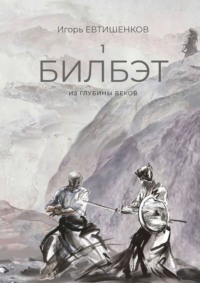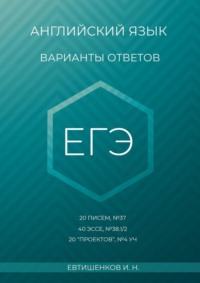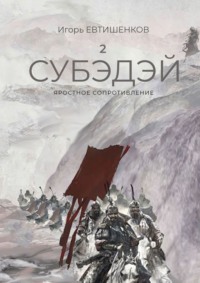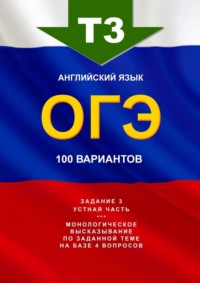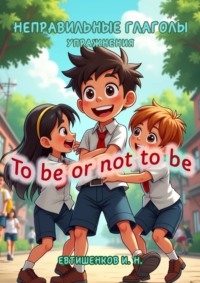
Полная версия
Английский язык, ОГЭ, 40 тестов
1. What present will you get, if you buy something today?
1) A tent.
2) A bicycle.
3) A watch.
Ответ: _______
2. On Sunday, Sophie is invited…
1) to attend an event in the sports centre.
2) to take part in a swimming competition.
3) to go to the city concert.
Ответ: _______
3. Why did Sally miss Alex’s call yesterday?
1) Sally’s phone was not working properly.
2) Sally had muted her phone for a concert.
3) Sally had left her phone at home.
Ответ: _______
4. What is Mark’s favourite subject?
1) Maths.
2) Science.
3) French.
Ответ: _______
5. Вы готовите тематическую радиопередачу с высказываниями пяти разных людей, обозначенных буквами А, В, С, D, Е. Подберите к каждому высказыванию соответствующую его содержанию рубрику из списка 1—6. Используйте каждую рубрику из списка только один раз. В списке есть одна лишняя рубрика. Вы услышите запись дважды.
1. They should be unplanned
2. They must have tasty food
3. They should be quite small
4. They must be memorable
5. They need simple entertainment
6. They need to be planned
Запишите в таблицу выбранные цифры под соответствующими буквами.
Говорящий …A… B… C… D… E
Рубрика
Вы помогаете своему другу, юному радиожурналисту, проанализировать подготовленное им для передачи интервью. Прослушайте аудиозапись интервью и занесите данные в таблицу. Вы можете вписать не более одного слова (без артиклей) из прозвучавшего текста. Числа необходимо записывать буквами. Вы услышите запись дважды.
6. Hobby
7. The country he/she wants to visit
8. Current job
9. Age of the respondent years old
10. Favourite dish
11. Regular sports activity
По окончании выполнения заданий 1—11 не забудьте перенести свои ответы в БЛАНК ОТВЕТОВ №1! Запишите ответ справа от номера соответствующего задания, начиная с первой клеточки. При переносе ответов на задания 5 и 6—11 цифры или буквы записываются без пробелов, запятых и других дополнительных символов. Каждую цифру или букву пишите в отдельной клеточке в соответствии с приведёнными в бланке образцами.
Раздел 2 (задания по чтению)
12. Вы помогаете своему другу, юному радиожурналисту, проанализировать подготовленное им для передачи интервью. Прослушайте аудиозапись интервью и занесите данные в таблицу. Вы можете вписать не более одного слова (без артиклей) из прозвучавшего текста. Числа необходимо записывать буквами. Вы услышите запись дважды.
1. Why were ravens considered to be scary and dangerous birds?
2. Why is keeping a raven as a pet really difficult?
3. How do ravens entertain themselves?
4. What is a raven’s essential diet?
5. How can you distinguish a raven from a crow?
6. Why are ravens important for Great Britain?
7. What tricks do ravens play to get and save their food?
A. For intelligence, ravens rate up with chimpanzees and dolphins. These birds have the largest brain of any bird species. Ravens can push rocks on people to keep them from climbing to their nests and play dead to scare other ravens away from a delicious meal. If a raven knows another raven is watching, it hides the tasty bits. It pretends to put the food in one place but hides it in another.
B. It’s amazing to watch ravens sliding on snow-covered roofs. For fun, they also roll down snowy hills. Ravens often play keep-away with other animals like wolves, foxes and dogs. They even make toys – a rare animal behaviour – from sticks, pine cones, golf balls, or rocks to play with each other or by themselves. When they feel bored, they mock other creatures like crows, cats and dogs and find it very amusing.
C. According to surveys, the ravens are one of the main reasons why tourists come to see the Tower of London. Nobody knows when the ravens first appeared there but there is a belief that at least six ravens must always remain on the territory of the Tower. Otherwise, the British Monarchy may fall. To prevent the birds from flying away their wings are clipped every three weeks.
D. In the past, in some cultures, people were truly afraid of these dark birds. In Germany, ravens were considered to be the incarnation of criminals’ souls. In Sweden, ravens were thought to be the souls of murdered people. And in Denmark, people believed that it was dangerous to look at ravens because you could turn into a raven yourself.
E. Sometimes people find injured ravens and take them home, but it’s really challenging. These birds require a lot of care, a lot of freedom and a lot of time. Ravens are wild creatures, and they cannot be treated like cats and dogs are. If the bird is strong and healthy, it is unfair and cruel to keep it in captivity. In some countries it’s even illegal. So if you really love and admire these birds, enjoy them from a distance.
F. These birds are often confused with each other because they are both black birds. Even people who are well aware of the differences between them can get confused. Ravens are larger than crows, with thicker beaks and longer tails. Ravens have a deeper voice than crows.
Запишите в таблицу выбранные цифры под соответствующими буквами.
Говорящий …A… B… C… D… E
Вопрос
Прочитайте текст. Определите, какие из приведённых утверждений 13—19 соответствуют содержанию текста (1 – True), какие не соответствуют (2 – False) и о чём в тексте не сказано, то есть на основании текста нельзя дать ни положительного, ни отрицательного ответа (3 – Not stated). Запишите в поле ответа цифру 1, 2 или 3, соответствующую выбранному Вами варианту ответа.
The 1900 House
«The 1900 House’ was a reality television programme in Britain. It took people back a hundred years to the time of Queen Victoria, when there were no computers, mobile phones or the Internet. The idea of the show was to give people an experience of living in the past.
A modern family, the Bowler family, spent three months living like people at the beginning of the 20th century. There were the parents (Paul and Joyce) and their four children (three daughters and a son). The cameras recorded them every day. The house didn’t have a telephone, a fridge, a TV set or even central heating. The Bowlers wore clothes from 1900 and ate the food that existed in England at that time. There wasn’t much to choose from. The main dishes on the table were meat and fish, and the day usually started with a cup of tea and porridge.
The father of the family, Paul Bowler, still went to work but in an old-fashioned uniform. He couldn’t read newspapers or use a computer. The mother, Joyce, became a housewife and stayed home. She did all the cleaning, washing and cooking. The children still went to school, but they changed their clothes on the way to and from school so their classmates wouldn’t know anything about this unusual project.
The Bowlers noticed that life at the beginning of the century was much slower. It was rather hard for them to get used to the new speed. For example, it took 28 minutes to boil water and make a cup of tea. And can you imagine cleaning the house without a vacuum cleaner or washing clothes without a washing machine? There wasn’t any toothpaste or modern shampoo. Without central heating nobody thought about a warm bath or a shower in the morning. Toothbrushes were made of pig and horse hair. Toothpaste was expensive so most people cleaned their teeth using salt or soda. The children thought it was horrible.
11-year-old Hilary said: «The most difficult thing was finding entertainment. We couldn’t go to the cinema or to a café. It was a new experience to be with the family for half a day or more. It was new and hard to be nice to each other all the time. But I really think we all became closer.»
17-year-old Kathryn remembered that she couldn’t wear any make-up. She had to wear a corset every day and had only three sets of clothes: one to wear every day, the second – to wear while cleaning, and the third was for special events, like celebrations.
When the show was over the Bowlers were asked: what did you miss most from the modern world? The father said it was a hot shower. The mother had longed to have a quick cup of tea. The daughters said it was the music, the hot water, shampoo and «normal sounds like the washing machine» which they missed. For the son it was pizza and the computer.
It’s interesting that the family was allowed to keep anything they wanted after the project. Joyce took her corset and each of the children took something from the house to remind them of their experience.
13. «The 1900 House’ is a TV programme about Queen Victoria’s life.
1) True 2) False 3) Not stated
Ответ: _______
14. There were only two rooms and a kitchen in the house.
1) True 2) False 3) Not stated
Ответ: _______
15. During the project Mr Bowler learnt the news from the newspapers.
1) True 2) False 3) Not stated
Ответ: _______
16. The children had to miss their school classes because of the project.
1) True 2) False 3) Not stated
Ответ: _______
17. Because of the project Hilary had to spend more time with her family.
1) True 2) False 3) Not stated
Ответ: _______
18. During the project it was difficult for the Bowler’s boy to live without his computer.
1) True 2) False 3) Not stated
Ответ: _______
19. After the project the family bought a new house.
1) True 2) False 3) Not stated
Ответ: _______
По окончании выполнения заданий 12—19 не забудьте перенести свои ответы в БЛАНК ОТВЕТОВ №1! Запишите ответ справа от номера соответствующего задания, начиная с первой клеточки. При переносе ответа на задание 12 цифры записываются без пробелов, запятых и других дополнительных символов. Каждую цифру пишите в отдельной клеточке в соответствии с приведёнными в бланке образцами.
Раздел 3 (задания по грамматике и лексике)
Прочитайте приведённый ниже текст. Преобразуйте слова, напечатанные заглавными буквами в конце строк, обозначенных номерами 20—28, так, чтобы они грамматически соответствовали содержанию текста. Заполните пропуски полученными словами. Каждый пропуск соответствует отдельному заданию 20—28.
An Arm and a Leg
20. Ben tried his __________ to meet his parents’ expectations – he studied well and never slacked off. GOOD
21. They paid for his college and helped him enter one of the Ivy League _____________. To do that they had to borrow money. Ben graduated and soon realised he had no wish to trade stocks and shares. UNIVERSITY
22. So he suffered a change of heart and left for Nepal to become a Buddhist monk as he _________ before. Their second son, Tom, was not as devoted to education as his elder brother, he often skived off at school and loved to show off. DREAM
23. He used to tell his parents he _________ to follow his brother’s footsteps NOT LIKE
24. and asked them to let him make ______ own choice. HE
25. By the age of 16 he hadn’t any plans, unfortunately and his parents realised that things started _____________ from their house. When they found out it was Tom who had been stealing them to sell them on, it was too late. APPEAR
26. Their younger son turned out to be a drug-addict and he ___________ live without them. They wasted a lot of money to take him into a drug rehabilitation center. It didn’t help. CANNOT
27. So they _____________ to sell their cars and some furniture for a song to pay it off. FORCE
28. Eventually, _________ good intentions cost an arm and a leg. THEY
Прочитайте приведённый ниже текст. Преобразуйте слова, напечатанные заглавными буквами в конце строк, обозначенных номерами 29—34 так, чтобы они грамматически и лексически соответствовали содержанию текста. Заполните пропуски полученными словами. Каждый пропуск соответствует отдельному заданию 29—34.
Strong Feelings
29. Julie couldn’t get through to Bill all day and was very upset. She wound herself up for the whole day and didn’t want to talk to her classmates. She even went home alone. She was so upset that she simply was _________ to talk. ABLE
30. As she came back home, her mother was chatting with ___________ on the phone in the kitchen. EXCITE
31. When she hung up, she smiled at Julie and said, «It’s Betty, she’s in the _______ now. I asked her to buy us some cookies. A penny for your thoughts, honey. You look sad. BAKE
32. What’s happened?» Julie didn’t say anything and just __________ went upstairs to her room. QUICK
33. She had no thoughts, nothing but _____________ and bitter resentment. DISAPPOINT
34. «It looks like love has settled in her heart,» thought her mother, feeling a familiar ________ feeling in her heart. PLEASE
По окончании выполнения заданий 20—34 не забудьте перенести свои ответы в БЛАНК ОТВЕТОВ №1! Запишите ответ справа от номера соответствующего задания, начиная с первой клеточки. При переносе ответов буквы записываются без пробелов, запятых и других дополнительных символов. Каждую букву пишите в отдельной клеточке в соответствии с приведёнными в бланке образцами.
Проверьте, чтобы каждый ответ был записан рядом с номером соответствующего задания.
Раздел 4 (задание по письму)
Для ответа на задание 35 используйте бланк ответов №2. При выполнении задания 35 особое внимание обратите на то, что Ваши ответы будут оцениваться только по записям, сделанным на бланке ответов №2. Никакие записи черновика не будут учитываться экспертом. Обратите внимание также на необходимость соблюдения указанного объёма электронного письма. Письмо недостаточного объёма, а также часть текста электронного письма, превышающая требуемый объём, не оцениваются. Укажите номер задания 35 в БЛАНКЕ ОТВЕТОВ №2 и напишите текст своего ответного электронного письма зарубежному другу по переписке.
35. You have received an email message from your English-speaking pen-friend Ben:
From: Ben@mail.uk
To: Russian_friend@oge.ru
Subject: Music
…Frankly, I don’t understand why some people like classical music. I adore rock and usually listen to it on my way home from school. If my favourite band comes to our town, I’ll definitely go to their concert.
…What kind of music do you like? Do you think it is necessary to have music lessons at school, why? What musical instrument would you like to play?…
Write a message to Ben and answer his 3 questions.
Write 100—120 words.
Remember the rules of letter writing.
Устная часть
Task 1
You are going to read the text aloud. You have 1.5 minutes to read the text silently, and then be ready to read it aloud. Remember that you will not have more than 2 minutes for reading aloud.
A personal computer is a multi-purpose programmable electronic device whose size, capabilities, and price make it feasible for individual use.
Early computer owners in the 1960s, invariably institutional or corporate, had to write their own programs to do any useful calculations with the machines. The very earliest microcomputers required hand-loading of a «bootstrap» program to load programs from external storage, tape cassettes, or eventually diskettes. In the 2010s, users have access to a wide range of commercial software, free software and free and open-source software, which are provided in ready-to-run or ready-to-compile form. Software for personal computers, such as applications and video games, are typically developed and distributed independently from the hardware or operation system manufacturers, whereas software for many mobile phones and other portable systems is approved and distributed through a centralized online store.
Task 2
You are going to take part in a telephone survey. You have to answer six questions. Give full answers to the questions. Remember that you have 40 seconds to answer each question.
Electronic assistant: Hello! It’s the electronic assistant of the New Supermarket Net. We kindly ask you to take part in our survey. We need to find out what teenagers think about shopping and shopping centers. Please answer six questions. The survey is anonymous – you don’t have to give your name. So, let’s get started.
Electronic assistant: What do you usually buy in your nearest shopping center?
Student:____________________________________________________________
Electronic assistant: Do you like to go shopping and why?
Student:____________________________________________________________
Electronic assistant: Do you often do the shopping online?
Student:____________________________________________________________
Electronic assistant: Why do you think the shopping centers are so popular?
Student:____________________________________________________________
Electronic assistant: Do you know people who hate shopping and what’s their explanation?
Student:____________________________________________________________
Electronic assistant: What time are the shopping centers crowded and why?
Student:____________________________________________________________
Electronic assistant: This is the end of the survey. Thank you very much for your help.
Task 3
You are going to give a talk about watching TV. You will have to start in 1.5 minutes and speak for not more than 2 minutes (10—12 sentences).
Remember to say:
• what kinds of films modern teenagers enjoy;
• where you prefer watching films: on TV, on the Internet or in the cinema, and why;
• what film you have seen recently, what it was about;
• what your attitude to watching TV is.
You have to talk continuously.
TEST 8
Раздел 1 (задания по аудированию)
Вы услышите четыре коротких текста, обозначенных буквами А, B, C, D. В заданиях 1—4 запишите в поле ответа цифру 1, 2 или 3, соответствующую выбранному Вами варианту ответа. Вы услышите запись дважды.
1. According to the announcement, the visitors of the shopping centre should…
1) leave the building immediately.
2) continue their shopping
3) get together in the central lobby.
Ответ: _______
2. Andrew asks Tom…
1) to lend him a bicycle.
2) to take care of his pet.
3) to help him in the garden.
Ответ: _______
3. What school subject does Helen like?
1) History.
2) Maths.
3) Science.
Ответ: _______
4. Nick’s brother is crying because…
1) his new toy is broken.
2) Nick refuses to play with him.
3) a cousin borrowed his toy car.
Ответ: _______
5. Вы готовите тематическую радиопередачу с высказываниями пяти разных людей, обозначенных буквами А, В, С, D, Е. Подберите к каждому высказыванию соответствующую его содержанию рубрику из списка 1—6.
Используйте каждую рубрику из списка только один раз. В списке есть одна лишняя рубрика. Вы услышите запись дважды.
1. They’re expensive
2. They’re beautiful
3. They’re boring
4. They’re colourful
5. They’re practical
6. They’re uncomfortable
Запишите в таблицу выбранные цифры под соответствующими буквами.
Говорящий …A… B… C… D… E
Рубрика
Вы помогаете своему другу, юному радиожурналисту, проанализировать подготовленное им для передачи интервью. Прослушайте аудиозапись интервью и занесите данные в таблицу. Вы можете вписать не более одного слова (без артиклей) из прозвучавшего текста. Числа необходимо записывать буквами. Вы услышите запись дважды.
6. Current job7. Favourite food8. Regular sports activity9. Age of the respondent years old.10. Country of birth11. HobbyПо окончании выполнения заданий 1—11 не забудьте перенести свои ответы в БЛАНК ОТВЕТОВ №1! Запишите ответ справа от номера соответствующего задания, начиная с первой клеточки. При переносе ответов на задания 5 и 6—11 цифры или буквы записываются без пробелов, запятых и других дополнительных символов. Каждую цифру или букву пишите в отдельной клеточке в соответствии с приведёнными в бланке образцами.
Раздел 2 (задания по чтению)
12. Вы проводите информационный поиск в ходе выполнения проектной работы. Определите, в каком из текстов A—F содержатся ответы на интересующие Вас вопросы 1—7. Один из вопросов останется без ответа. Занесите Ваши ответы в таблицу.
1. What goods were made from the plant, the symbol of Scotland?
2. What is the national sporting event of the country?
3. What endangered plants grow in the Scottish Highlands?
4. What plant brings luck and success?
5. What is the stereotype of Scotland like?
6. Why is Scotland an attractive place for those who love sports?
7. What is the modern profile of Scotland like?
A. Thanks to television and films, Scotland is often seen by the rest of the world as a magical country, a land of misty mountains and the home of a lake creature called Nessie. This is the image most people have in mind. The truth, however, is completely different from the way the world thinks of Scotland. You may be surprised to find out that most Scots live in the lowlands and don’t believe in Nessie.



